Черепаший мост на реке Александра – Путеводитель (с треками)
Черепаший мост на реке Александр назван в честь живущих поблизости черепах с мягким панцирем. И кроме них, можно прогуляться вдоль реки.
Оглавление
Карта
Черепаший мост проходит через реку Александра в районе Кфар Виткин.. Самый простой способ добраться - ввести “черепаховый мост” в Waze.
Направления для водителей: Ссылка на Вейз и Ссылка на карты Google
Направления общественного транспорта: Ссылка на Моовит
Интерактивная карта местности:
Входная плата
Бесплатно.
Стоянка
Возле моста есть бесплатная грунтовая парковка.. Но так как это популярное место, парковка быстро заполняется по субботам и праздникам. Поэтому, Я хотел бы предложить, прибывающих рано.
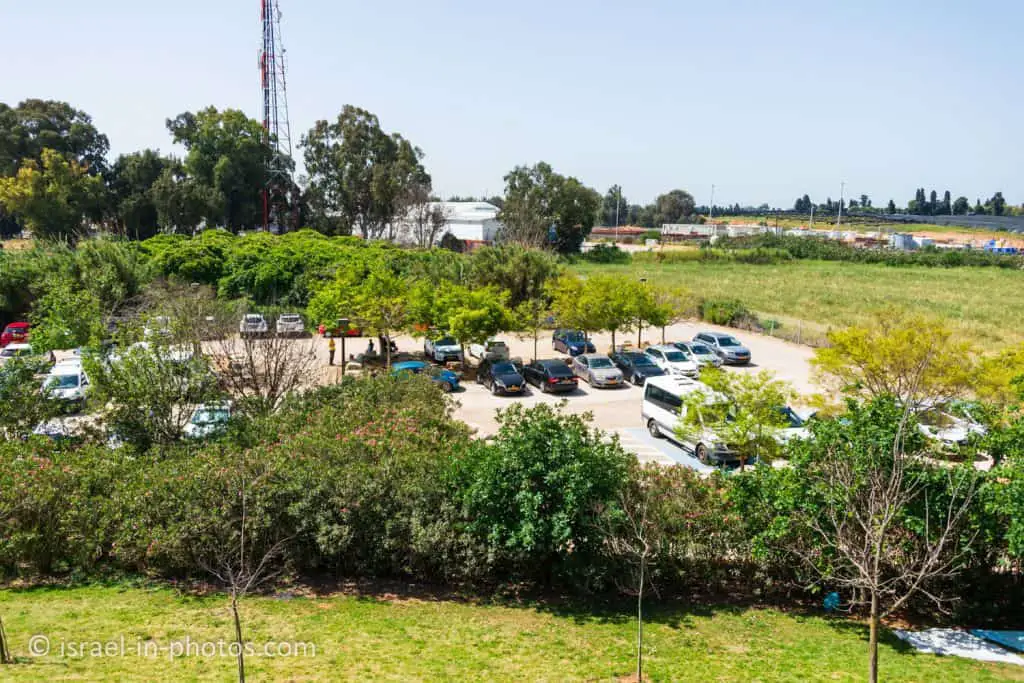
Часы работы
Вы можете посетить это место в любое время. Но если ваша главная цель - увидеть черепах или прогуляться по одной из троп, ты должен делать это в дневное время. Кроме того, выше вероятность увидеть черепах вне воды рано утром.
Треки
Черепаший мост может быть прекрасным местом для короткого семейного посещения (обычно около часа).. Вы можете остаться подольше, устроив пикник или отправившись на трек. Пройдемся по самым популярным тропам.
Вот интерактивная карта с сайта israelhiking.osm.org.il, где обозначены тропы:
Вот подробности самых популярных маршрутов:
| # | Имя | Цвет тропы на карте выше | Описание | Расстояние (км) | Общий подъем и спуск (метры) | Заметки |
| 1 | К дороге #4 | Красный | Вторую машину можно оставить в отмеченном месте или на парковке Beit Yanai Beach.. | 3.3 | 4 | Это не круговая тропа. Но вы можете остановиться в любой момент и вернуться к черепашьему мосту.. |
| 2 | Хирбат Самара | Синий | Следуйте по израильской национальной тропе в Хирбат Самара.. | 2 | 20 | Если у вас нет другой машины от Хирбат Самара, вы можете вернуться по тому же пути. |
| 3 | Пляж Бейт Янай | Зеленый | Это расширенная версия предыдущего пути. Из Хирбата Самара, продолжить путь до пляжа Бейт Янай. | 3.7 | 40 | Вторую машину можно оставить в отмеченном месте или на парковке Beit Yanai Beach.. |
Все упомянутые трассы двунаправленные.. Таким образом, вы также можете сделать черепаховый мост конечной точкой. Но планируйте быть на Черепашьем мосту либо утром, либо днем (другими словами, когда не жарко). Это повысит ваши шансы увидеть черепах вне воды..
Смотровая башня
Мы начнем наш визит с восхождения на смотровую башню.. Вы можете получить 360-градусный обзор окрестностей сверху.
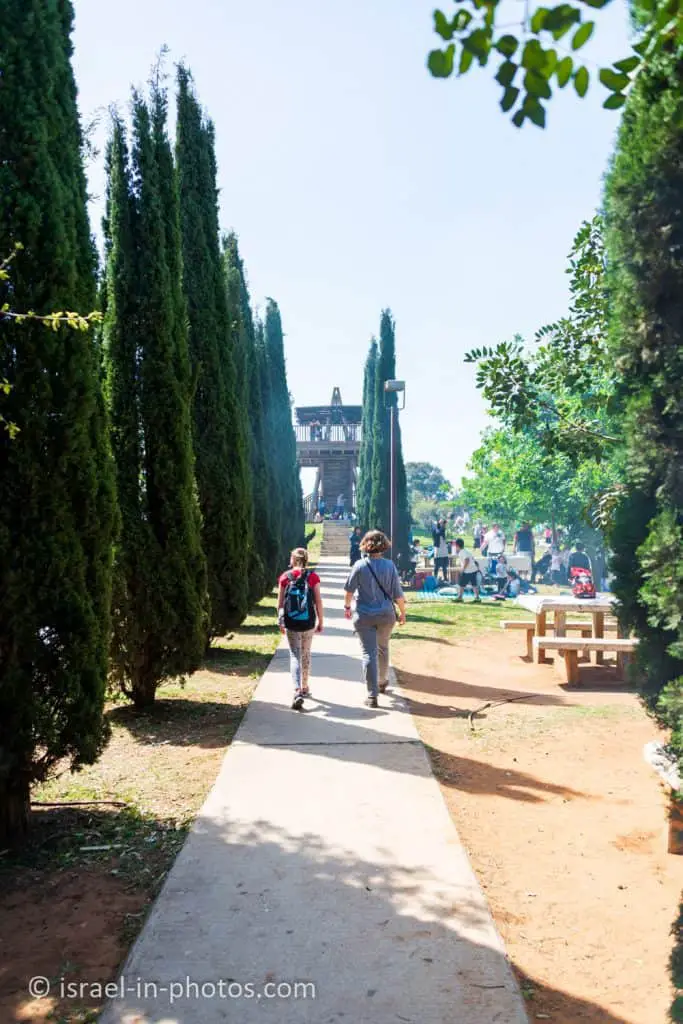
Вы не можете увидеть черепаший мост на следующем фото, так как он находится за правой линией деревьев.. Но вы можете увидеть реку Александра. Если вы внимательно посмотрите, затем на горизонте, вы увидите электростанцию Hedera в центре фото.
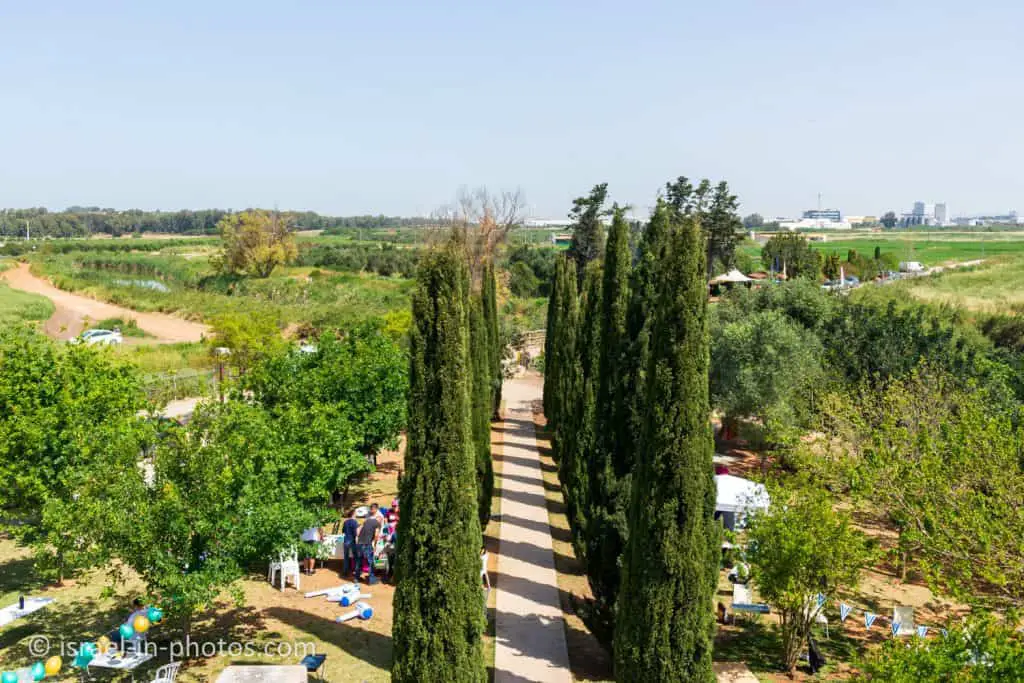

В приведенном выше фото, вы можете увидеть детскую площадку. Вот более близкий взгляд:
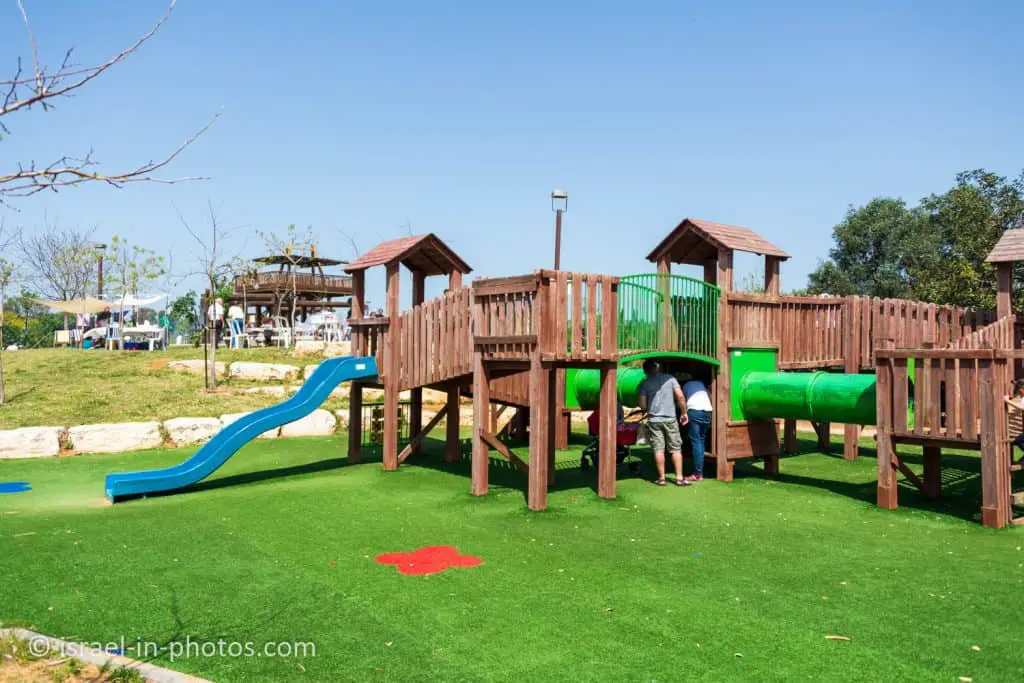

Пикник и Барбекю
Черепаший мост популярен, как видно на фотографиях с вершины смотровой башни. Кроме того, многие люди устраивали пикники и барбекю. И это потому, что наш последний визит состоялся во время Дня независимости Израиля. 2021.
Но с учетом сказанного, взгляните на следующий знак. Вы должны взять с собой весь мусор. Также, рыбалка и заход в воду запрещены.
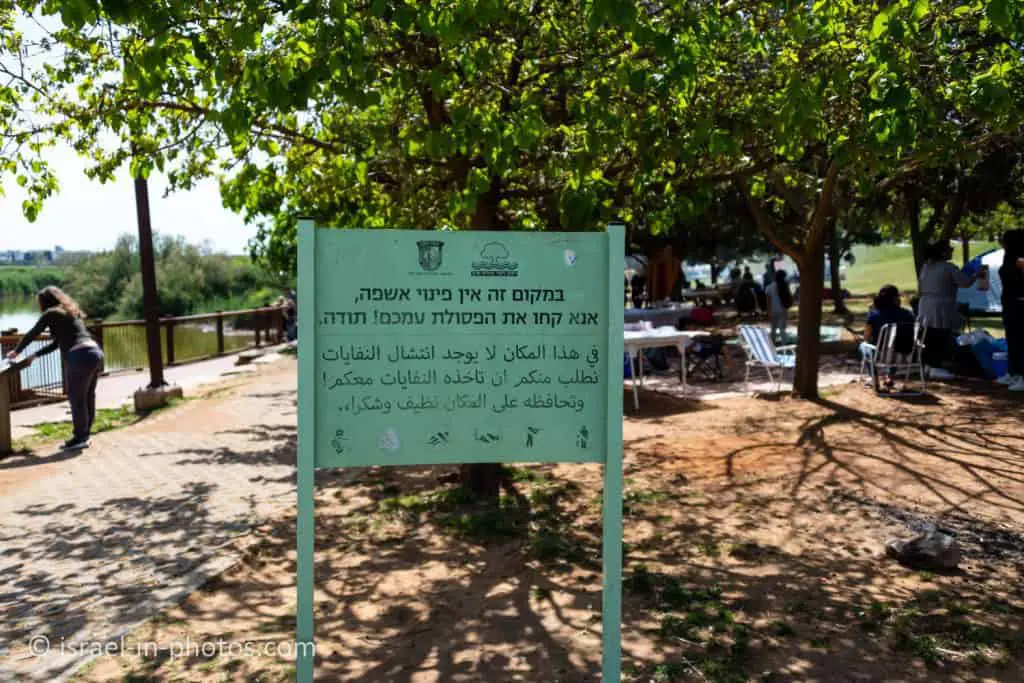
Черепаший мост
И сейчас, давай приблизимся к воде. На следующей фотографии, вы можете увидеть черепаший мост.
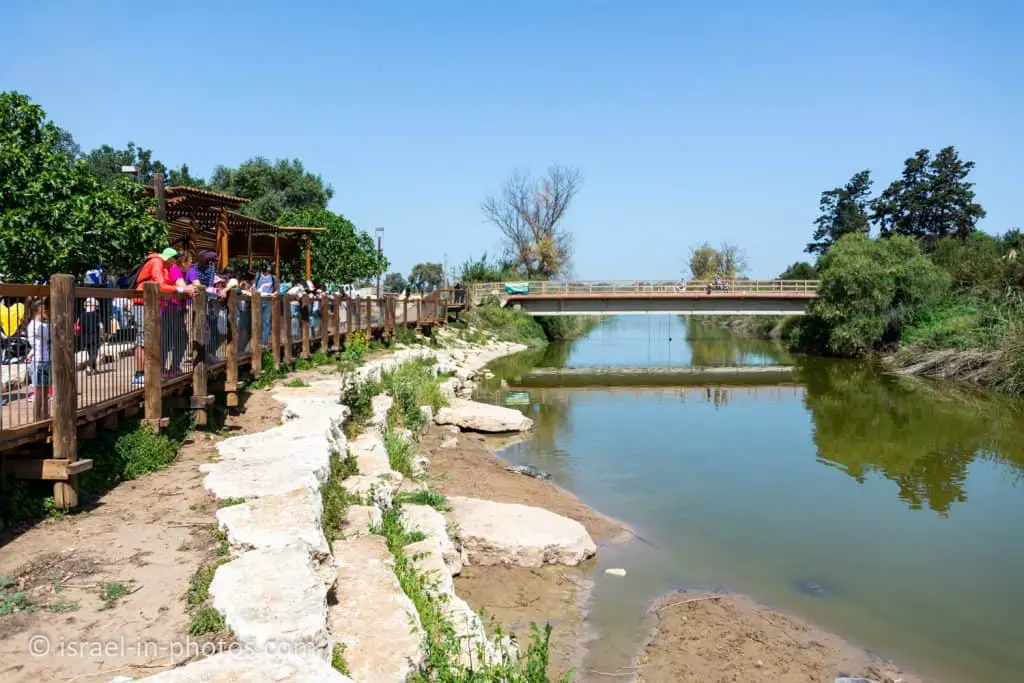
Как уже упоминалось выше, этот мост получил свое название в честь нильских черепах софтшелл. Многие виды обитали в этом регионе., но только черепахи пережили промышленное загрязнение в прошлом веке. И даже сегодня, вы можете увидеть только горстку птиц и небольшую группу черепах.
Я много раз был на Черепашьем мосту. Раньше забора не было, и вы могли подойти очень близко к черепахам. Барьер, вероятно, был построен из-за того, что люди продолжали кормить черепах..
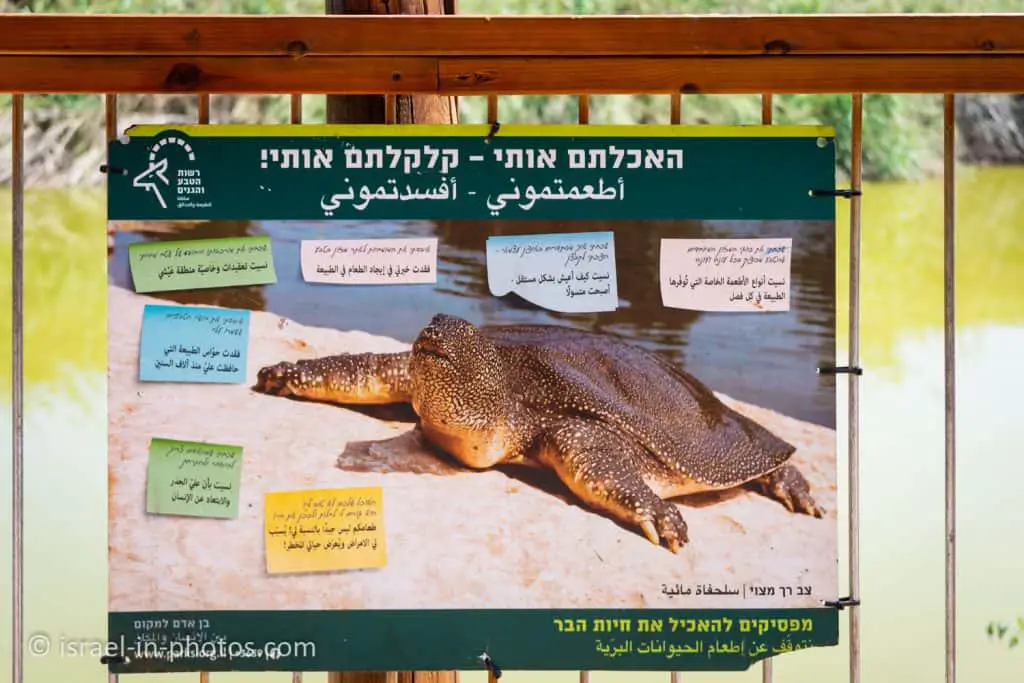
Нильская мягкотелая черепаха
Нильскую черепаху софтшелл также называют африканской черепахой софтшелл (Trionyx triunguis).. Это пресноводный вид черепах..
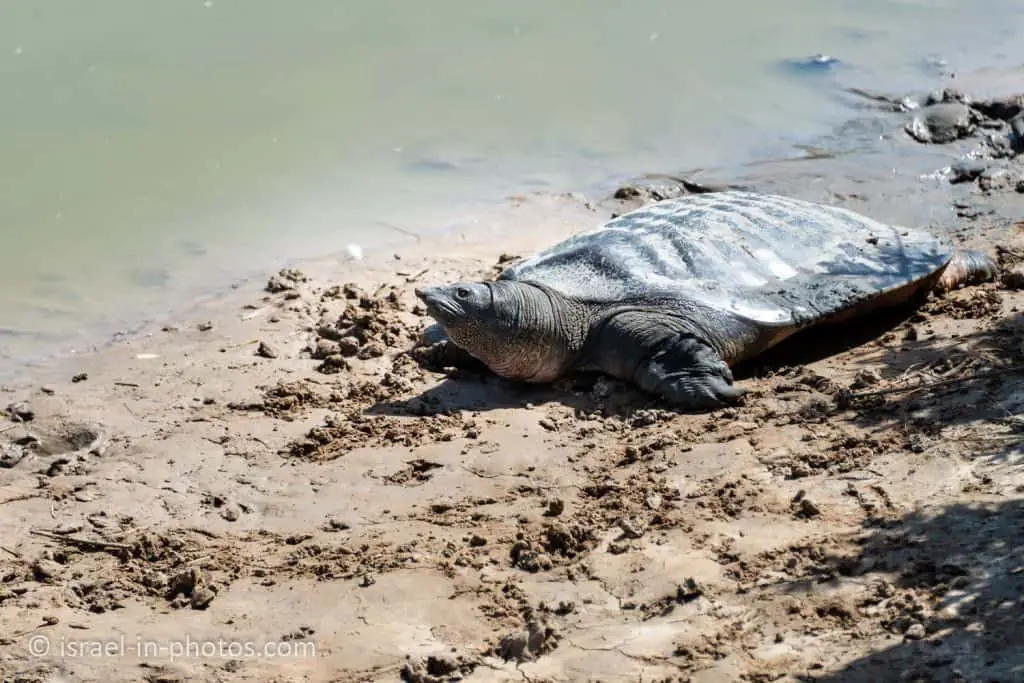
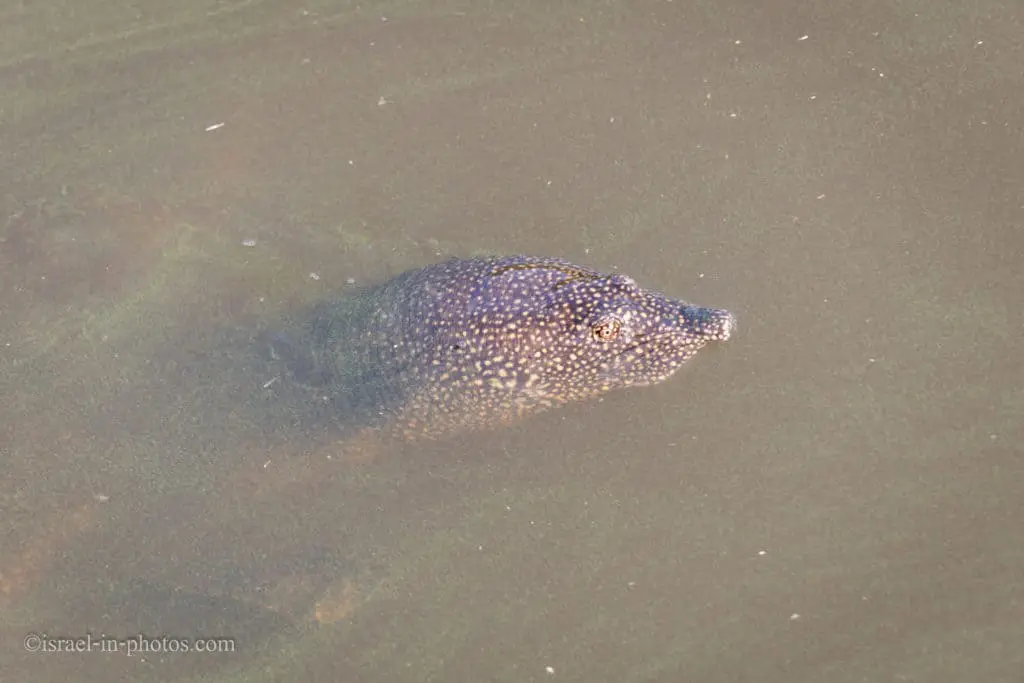
Совет: если вы хотите увидеть черепах на пляже, вы должны прибыть рано (в зависимости от сезона, но обычно до 10:00). Когда становится теплее, они попадут в воду.
Они могут выглядеть маленькими при плавании, но они довольно большие. Софтшелл черепахи могут достигать одного метра в длину и весить до 50 кг. Софтшелловые черепахи произошли из пресных озер Восточной Африки.. Это плотоядное животное, которое питается червями., Рыбы, и другие мелкие животные, водные.
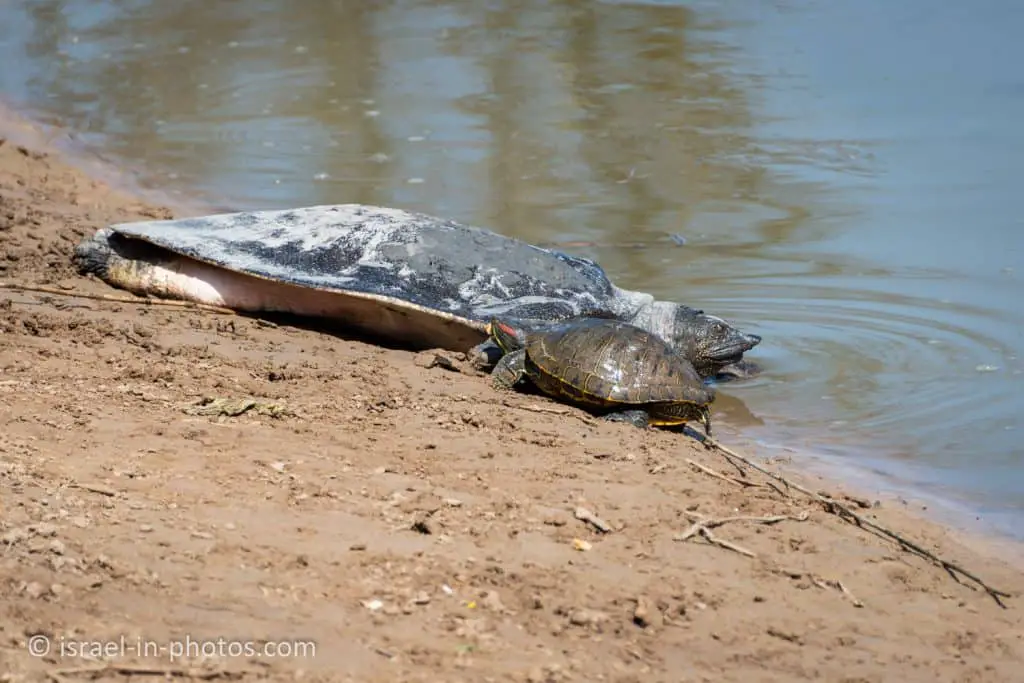
Плоское тело нильской черепахи софтшелл идеально подходит для жизни в ручьях., а мембраны на конечностях делают его отличным пловцом. Хорошо маскируется в мутной воде и на мутных руслах., и это долго, гибкая шея позволяет ему выглядывать из воды и осматривать окрестности. Как и многие виды рептилий, Нильский софтшелл любит загорать. Его острые когти позволяют ему лазить по растительности и гладким камням на берегах ручья.. Питается насекомыми, моллюски, и земноводных, а также на различных растениях и орехах.
Нильская мягкотелая черепаха (Trionyx triunguis), обитающая в ручьях Израиля, принадлежит к древнему семейству под названием Trionychidae.. В это семейство когда-то входили сотни видов, которые процветали по всему миру., но сейчас есть только 13 родов и 22 виды остались. Большинство из них живут в Африке, Азия, и Ближний Восток, и некоторые на американском континенте. Самый распространенный вид в Израиле считается самым крупным в Африке (его раковина может достигать 90 см в длину) и может жить десятилетиями.
Нильская черепаха софтшелл была впервые описана науке в 1775, когда его нашли в реке Нил, дав ему популярное название. Ученые были удивлены, обнаружив всего несколько десятилетий назад, в 1970-х, насколько широко его распространение на самом деле - от пустыни Сахара и на юг, в устьях рек в Западной Африке, а также в Кении, Сомали и другие места. Софтшелл Nile прибыл в Израиль через дельту Нила., в Средиземное море, а оттуда в разные потоки. Он прибыл в Ливан, Сирия, и Турция точно так же.
Научные исследования показали, что популяция нильских мягкотелых черепах в потоке Александер в Израиле является одной из трех основных популяций этого вида в бассейне Средиземного моря (две другие обитают в реках на юго-западе Турции).. Все еще, никто не смог точно оценить количество взрослых нильских софтшелл в бассейне Средиземного моря.. Согласно прошлым опросам, их количество составляет примерно 500 или менее.
Источник: если не указано иное, все цитаты были взяты из Управление природы и парков Израиля
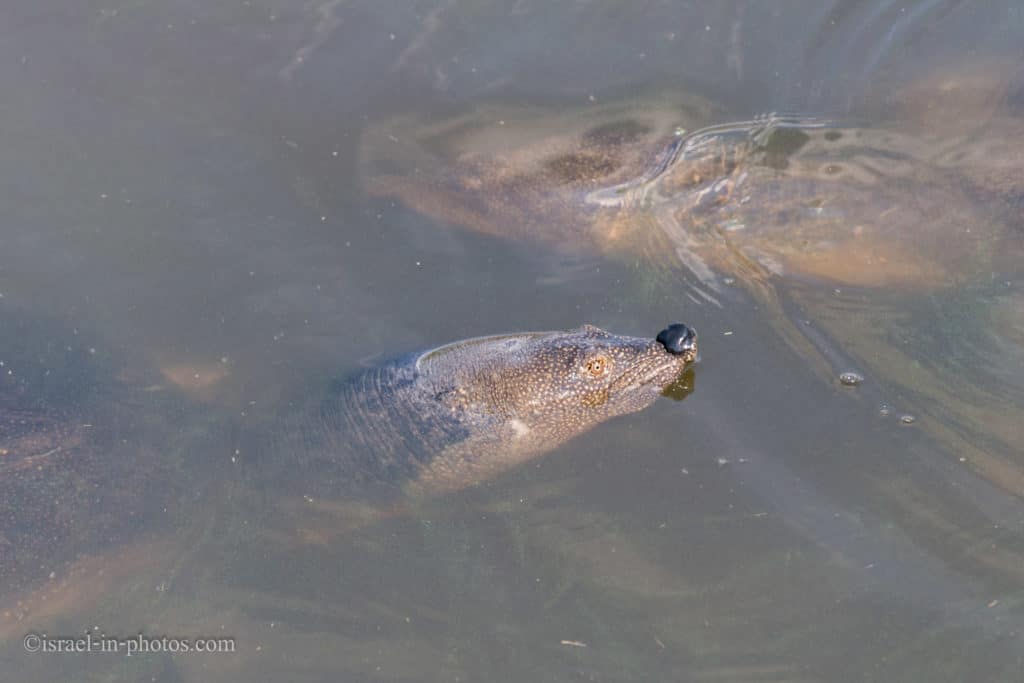
Различные природоохранные организации и международные конвенции определяют популяцию нильской мягкой черепахи в странах Средиземноморья (Египет, Израиль, Ливан, Сирия, и Турция) как подвид, нуждающийся в особом уходе. В 1996, Международный союз охраны природы заявил, что популяция нильского софтшелла находится под угрозой исчезновения.. В исследовании, проведенном в Египте, Сирия, и Ливан, живых особей не обнаружено, а скорее лишь остатки ракушек в руках местных рыбаков.
Не секрет, что как зеленая морская черепаха, Нильская черепаха софтшелл в реальной опасности, будь то прямая угроза охоты или рыбалки или косвенная, по развитию, продолжающееся загрязнение, высыхание влажных местообитаний, и другие факторы.
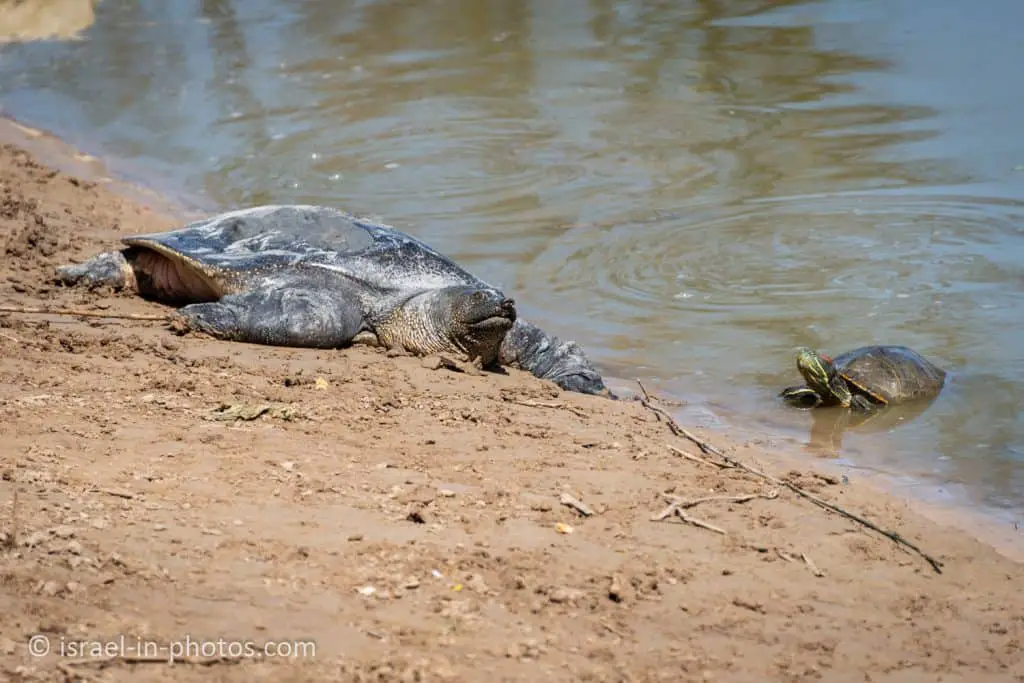
В недалеком прошлом, Нильские черепахи софтшелл были в изобилии в этой стране. по факту, до начала двадцатого века, их можно найти в большинстве прибрежных водотоков. После основания Израиля, исследователи до сих пор сообщают о сотнях взрослых нильских черепах софтшелл и нескольких тысячах молодых.. Но как уже отмечалось, изменение среды обитания, ограничение, и фрагментация за последние несколько десятилетий, а также другие экологические проблемы, такие как загрязнение и различная деятельность человека, привели к значительному сокращению их населения.
Сегодня самые большие популяции обитают в заповеднике Хула и национальном парке Александровский ручей., и, по оценкам, несколько десятков особей в каждой из этих сред обитания. Западная часть ручья Александра считается основным местом гнездования нильских черепах софтшелл в Израиле; в период размножения здесь можно увидеть десятки гнезд..
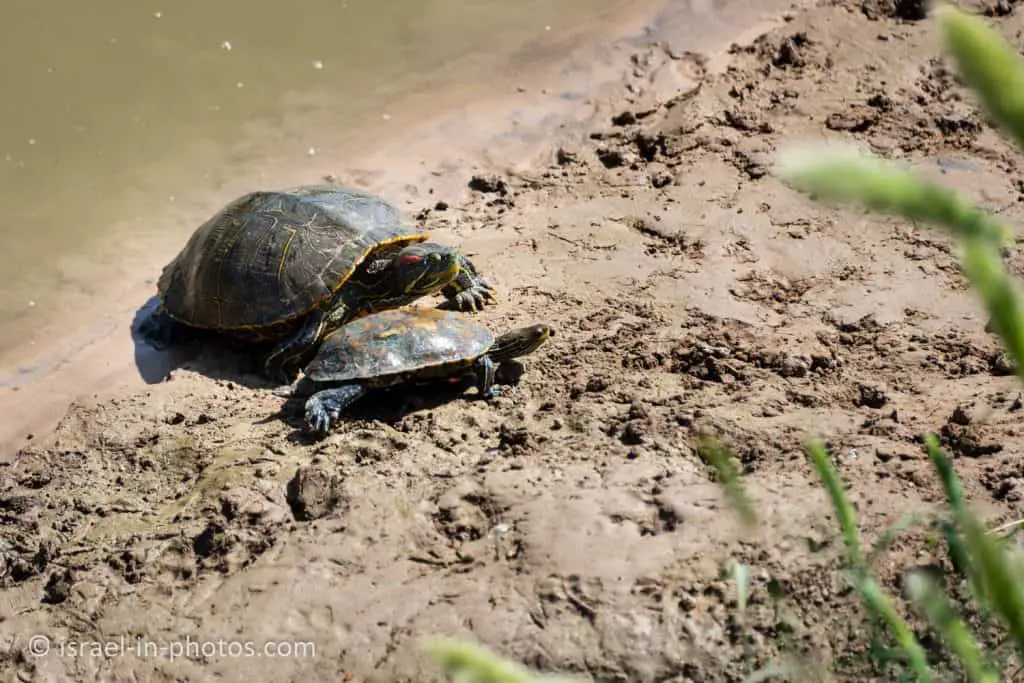

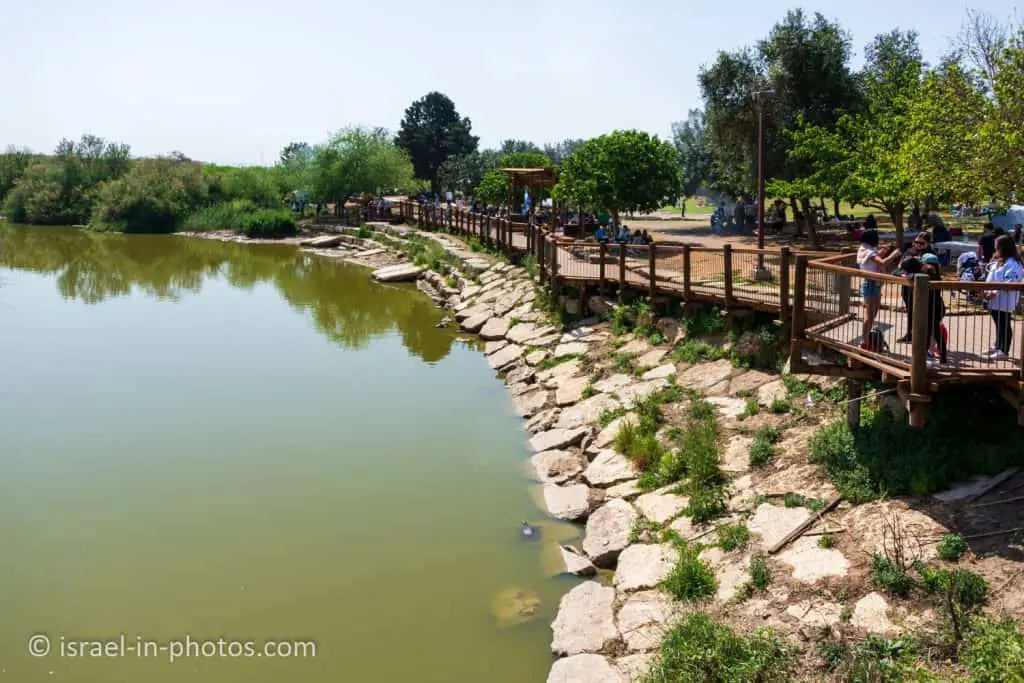
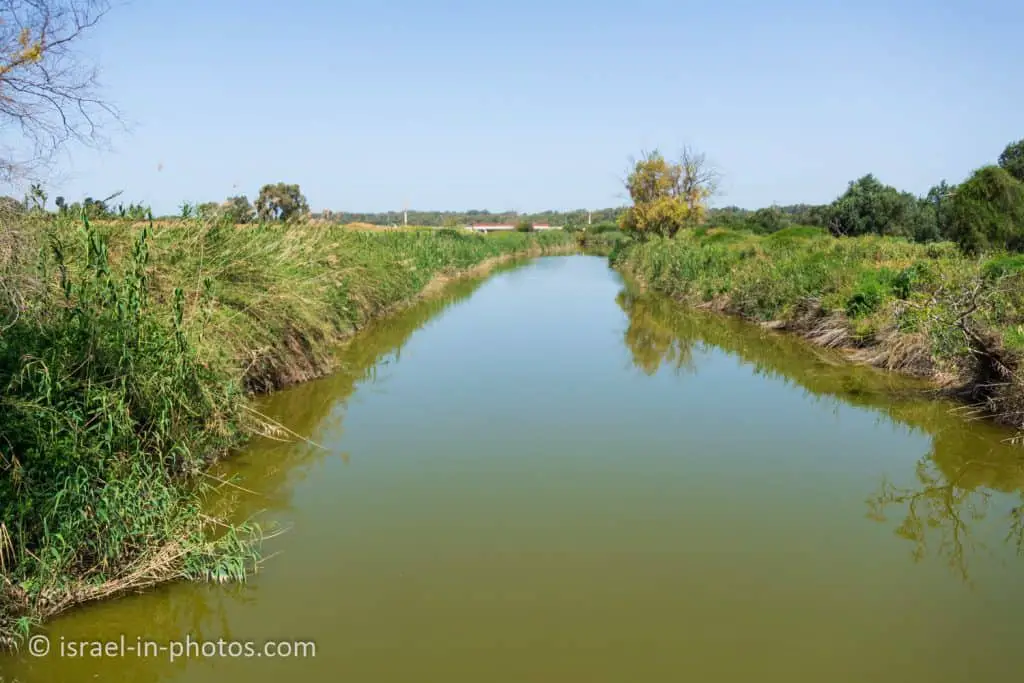
Когда вы идете по мосту, вы увидите кофейню. И здесь же начинаются тропы. На следующем фото показана маркировка национальной тропы Израиля (на дереве слева).. Если вы последуете за ним, он приведет вас в Хирбат Самара и Пляж Бейт Янай.
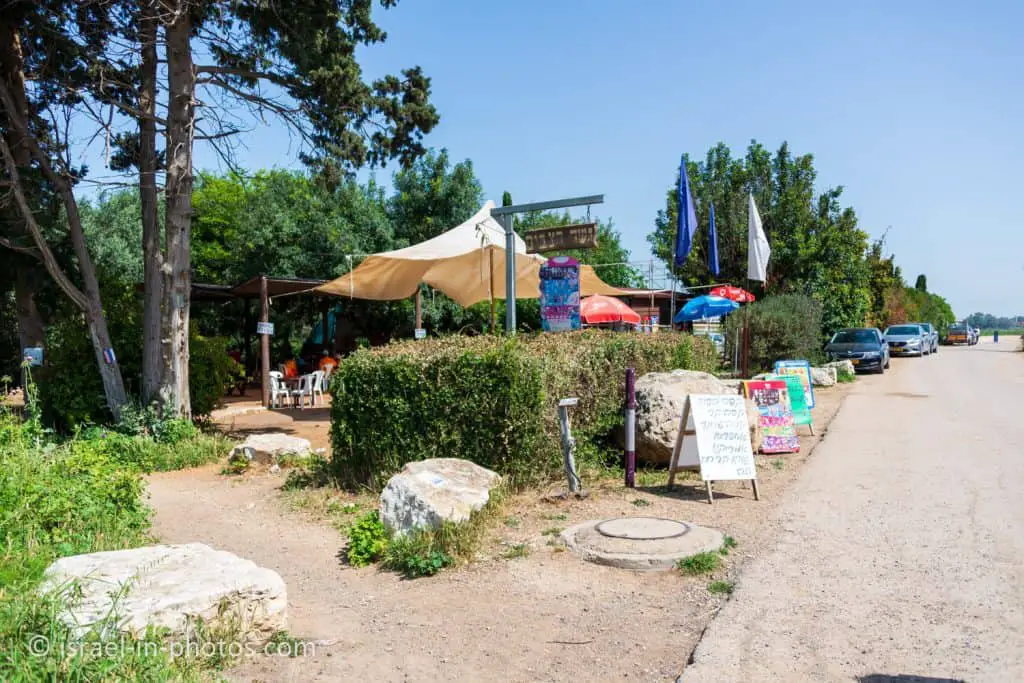
Резюме
Черепаший мост на реке Александра - прекрасное место. Вы можете ненадолго приехать, чтобы увидеть и показать своим детям черепах из софтшелл.. Кроме того, вы можете устроить там пикник или отправиться в поход. Но поскольку это популярное место выходного дня, рекомендую приходить пораньше.
Вы когда-нибудь были на Черепашьем мосту? Расскажите нам о своем опыте в комментариях ниже..
Это все на сегодня, и увидимся в будущих поездках!
Следите за обновлениями!
Дополнительные ресурсы
Вот несколько ресурсов, которые я создал, чтобы помочь путешественникам:- Планировщик поездок с достопримечательностями и маршрутами - страница которая поможет вам создать идеальный маршрут путешествия.
- Какое лучшее время для посещения Израиля? Чтобы ответить на этот вопрос, мы учтем погоду, цены, каникулы, фестивали, и многое другое.
- Информация и советы для туристов в Израиле ответит на самые распространенные вопросы туристов об Израиле (в том числе о безопасности, паспорта, погода, валюта, опрокидывающийся, электричество, и многое другое).
- Национальные парки и заповедники Израиля включить полный список, Топ десять, карта, билеты (Израиль Пасс, Матмон, комбо), и кемпинги.
- Если вы ищете вещи, чтобы сделать, вот страницы для Иерусалим, Тель-Авив, Хайфа, Галилейское море, Акко, Эйлат, Назарет, Цфат, и Махтеш Рамон.



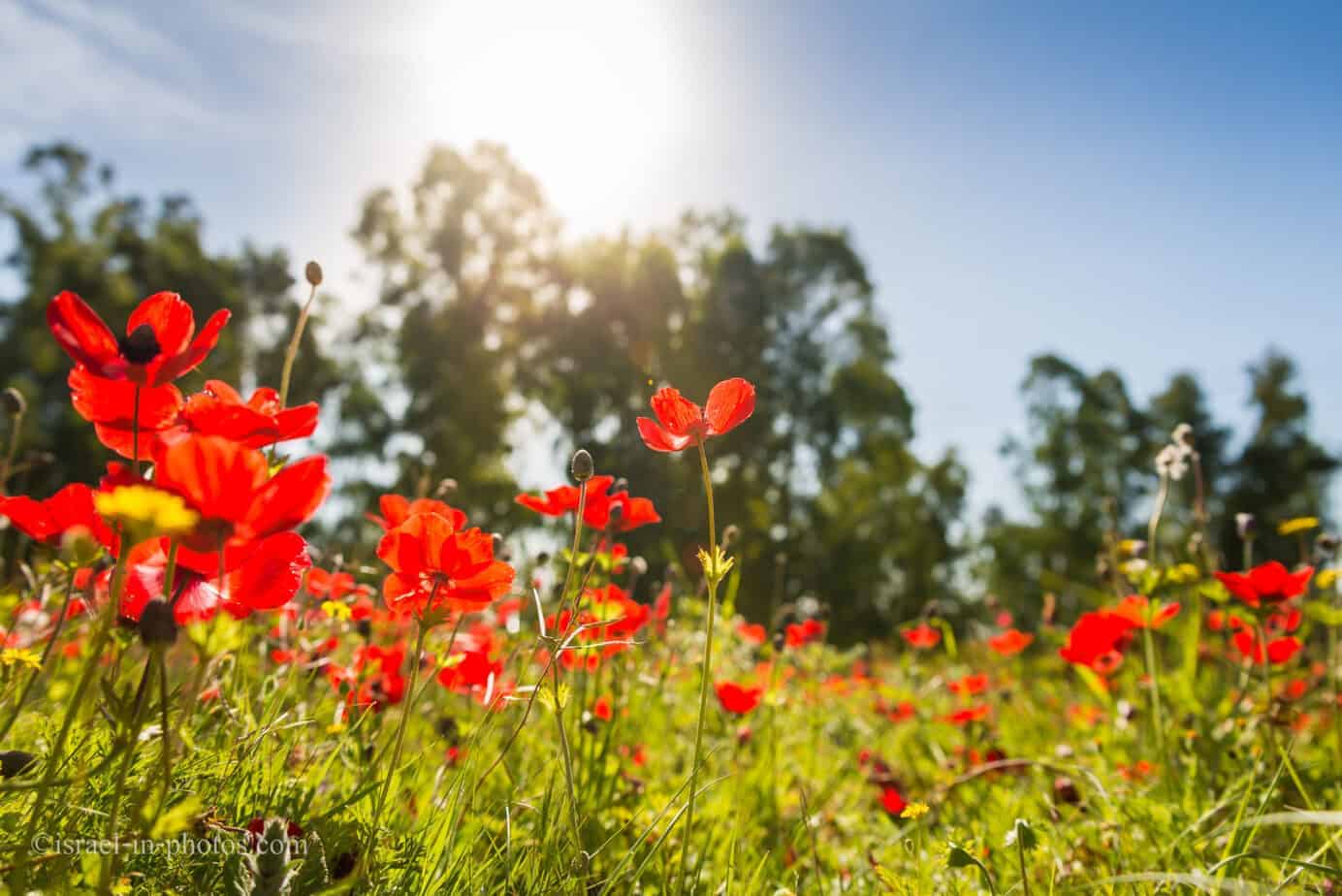
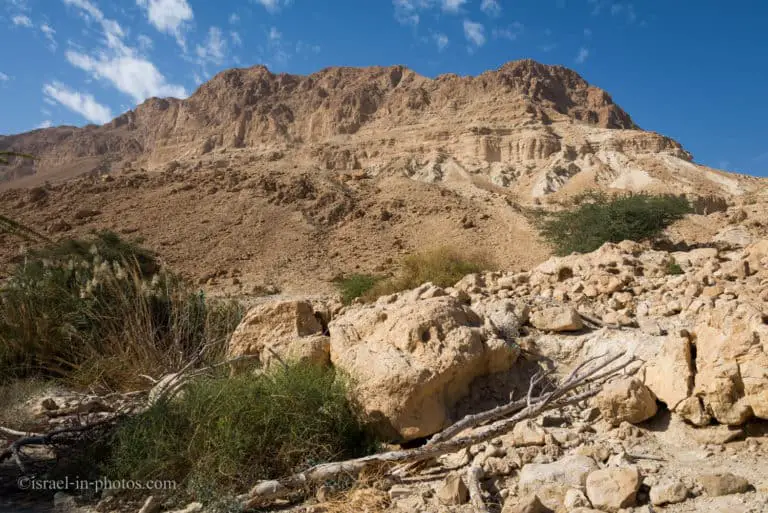


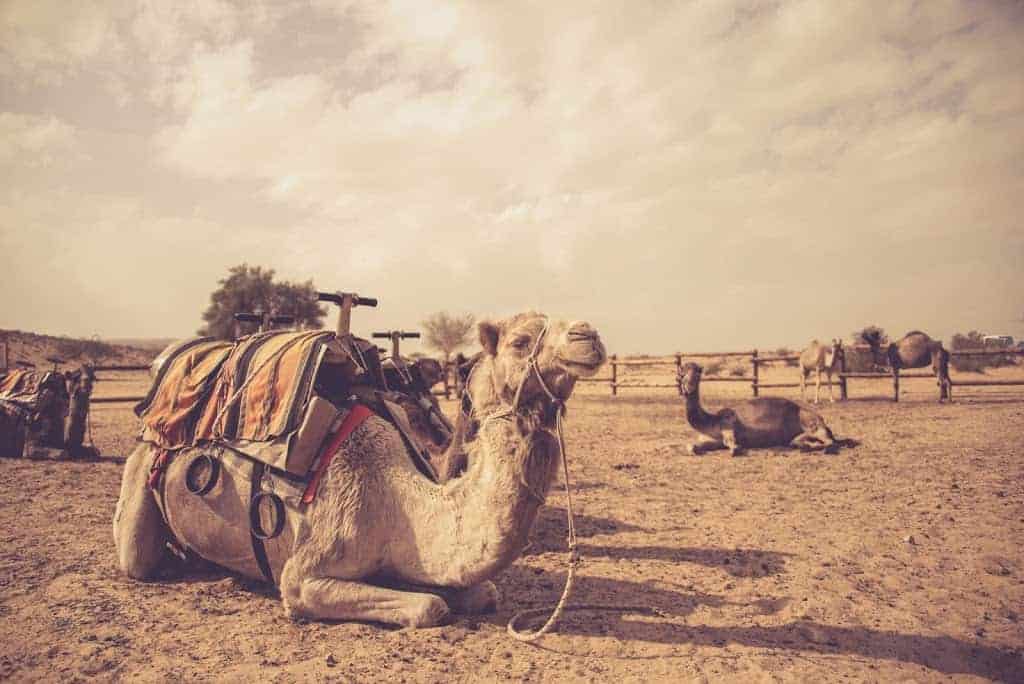
Привет, в какое время года лучше всего посетить черепах на Александровском мосту, пожалуйста
Привет Харви,
Я был там много раз, и черепахи всегда были там (круглый год). Но если вы придете к 10:00 или позже, скорее всего они будут в воде. Таким образом, если вы хотите увидеть их снаружи, прогреваться на солнце, Я предлагаю прибыть рано. Вероятно, раньше 9:00.